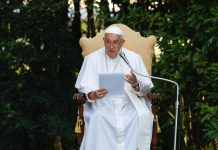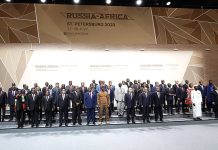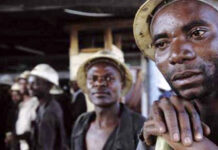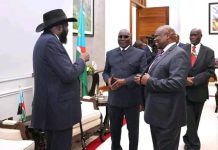Original Article by Ciku Kimeria for Quartz Africa
In 1890, the French staged a bloody siege in the Segou royal palace, the capital of the Toucouleur empire that spanned modern day Guinea, Senegal and Mali. This siege and the violent capture of the city of Ouossebougou in 1890 marked the end of the Toucouleur empire and the transfer of control of the region to French colonial rule.
In addition to the loss of lives and the destruction of property, the French officials plundered over a thousand pieces of significant cultural heritage to the people—including the saber of the founder of the empire, El Hadj Omar Tall.
Almost 130 years later, the saber that bears a specific symbolic, cultural and spiritual significance has finally been returned to Senegal in a very emotional hand-over ceremony that saw his ancestral family travel from various parts of West Africa to witness this historic moment. It was a moment of victory for the descendants of the anti-colonial hero, who have been demanding the return of his artifacts since 1944. The artifacts including the saber, manuscripts, jewels are mostly spread out across three of France’s largest museums.Up to 90% of Sub-Saharan Africa’s material cultural legacy is outside of the continent.
Up to 90% of Sub-Saharan Africa’s material cultural legacy is outside of the continent, according to the French government-commissioned 2018 report by Senegalese economist Felwine Sarr and French historian Bénédicte Savoy. The report calls for the restitution of Africa’s stolen assets highlighting that most of these were looted by European colonial powers, stolen during ethnographic missions or acquired under questionable conditions in various markets.
While the public debate has mostly focused on African art, repatriation encompasses various elements of African cultural heritage. This includes art and archives, ceremonial objects, human remains, natural history specimens, and intangible cultural heritage like sound recordings and photographs. The best-case scenario figure for the number of artifacts any national museum archives in Sub Saharan Africa is 3,000—and even then, most of them are of little importance or significance when compared to those in European museums.
| How many African artifacts are in Europe’s top museums? | |
|---|---|
| Museum | No. |
| Musee Royale de l’Afrique Centrale, Belgium | 180,000 |
| Humboldt Forum, Germany | 75,000 |
| Musée du Quai Branly Jacques Chirac, France | 70,000 |
| British Museum | 69,000 |
| Weltmuseum of Vienna, Austria | 37,000 |
Since the release of the report, no objects have been returned to the countries they are from. A recent $15 million, four-year initiative by George Soros’ Open Society hopes to spur momentum in reparation efforts through legal, financial and technical support to governments, regional bodies, museums, universities and civil societies. Concerted efforts and significant funding are needed to support claims for restitution as communities demanding their looted items will undoubtedly come up against legal hurdles—such as the “inalienability of public French art collections.”
This simply means there are laws stating any public French art collections belongs to the state and cannot be given back (even when said assets were looted.) This is the convenient legal barrier that has prevented countries and communities that have been asking for their treasured assets from getting them back.
| African artifacts at Musée du quai Branly, Paris | |
|---|---|
| Country | No. |
| Chad | 9,296 |
| Cameroon | 7,838 |
| Madagascar | 7,590 |
| Mali | 6,910 |
| Ivory Coast | 3,951 |
| Benin | 3,157 |
| Congo-Brazzaville | 2,593 |
| Gabon | 2,448 |
| Senegal | 2,281 |
| Guinea | 1,997 |
For the past three years, Benin has been officially asking France back for the return of anthropomorphic (half human-half animal) statues that were looted during the sacking of the Abomey place in 1892. The statues have both a spiritual and historic value for Benin and are irreplaceable pieces of cultural property and heritage.
These statues are part of 26 artifacts of the 5,000 artifacts Benin has requested from France whose return to the country is mired in legal challenges. Their requests have in the past been continuously declined with France stating that they are now part of French cultural property and heritage.

In Ethiopia, Afromet (the Association For the Return Of the Magdala Ethiopian Treasures) has fought for the return of cultural items seized by the British army at Magdala in 1868. Last year, the country got a sort of bitter-sweet response to their request for the return of artifacts including a gold crown and a royal wedding dress, which were taken during the battle at Magdala.
Britain’s Victoria & Albert Museum agreed to return certain artifacts as part of a long-term loan—sparking widespread debate about restitution. The battle of Magdala arose from a British military expedition to secure the release of British hostages taken by Emperor Tewodros II. The British victory culminated in the emperor’s suicide and the destruction of his fortress. Hundreds of artefacts were plundered from Magdala with the emperor’s treasury being emptied and 15 elephants and 200 mules needed to transport the looted assets.

Felwine Sarr, the co-author of the restitution report states that the path to restitution is not an easy one, but a vital one in the process of decolonization. Challenges that will be faced include European countries putting up roadblocks to restitution, but also the need to engage African citizens in the discussions.
“People first need to know what was taken from them. Then they will realize that this is not an elite discussion, but one that concerns them—their history, their heritage, their legacy.”

































